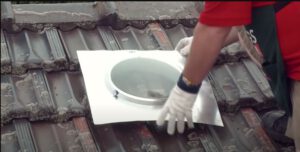Can I install a solar roof tile system on my Australian home?
Posted on: June 13, 2023, by : roofcont Australia, renowned for its abundant sunshine, is one of the perfect places to utilise solar energy. One emerging technology capturing the attention of Australian homeowners is solar roof tiles, also known as photovoltaic (PV) shingles. These are solar panels designed to look and function like conventional roofing materials, while also generating electricity. But the question remains: can you install a solar roof tile system on your Australian home? The answer is a resounding yes.
Australia, renowned for its abundant sunshine, is one of the perfect places to utilise solar energy. One emerging technology capturing the attention of Australian homeowners is solar roof tiles, also known as photovoltaic (PV) shingles. These are solar panels designed to look and function like conventional roofing materials, while also generating electricity. But the question remains: can you install a solar roof tile system on your Australian home? The answer is a resounding yes.
Solar Roof Tiles: An Overview
Solar roof tiles are a relatively new concept in Australia, but they’re becoming increasingly popular due to their aesthetic appeal and energy-saving benefits. Unlike traditional solar panels, solar roof tiles are integrated into the roof itself, providing a seamless appearance that many homeowners find attractive. Furthermore, they offer a sustainable solution to power needs, potentially reducing electricity bills and contributing to a greener environment.
Installation Process
Installing solar roof tiles is similar to installing traditional roof shingles or tiles, with a few additional steps. The roof’s structure and integrity must be strong enough to support the weight of the solar tiles. A professional solar installer can assess this and ensure the roof is suitable. Once this is established, the old roofing material is removed, and the solar tiles are installed in its place. Each tile is connected to the home’s electrical system to generate power.
Factors to Consider
While the installation process might sound straightforward, several factors must be considered. The orientation and slope of your roof play a vital role in the effectiveness of solar roof tiles. For optimum energy production, a north-facing roof with a slope between 15 and 40 degrees is ideal in Australia. However, solar tiles can still generate a significant amount of energy on east or west-facing roofs.
Regulations and Permit Requirements
It’s also crucial to consider local regulations and permit requirements. Most Australian states and territories have specific rules for solar installation, including potential restrictions on heritage-listed properties or those in certain council areas. It’s advisable to check with your local council or a professional installer to ensure you’re meeting all necessary requirements.
 The Australian Energy Regulator (AER) provides information for consumers about the rules and regulations surrounding solar energy. This guide outlines the technical requirements for installing solar panels, including how equipment must be connected to the electricity grid in a safe and secure way.
The Australian Energy Regulator (AER) provides information for consumers about the rules and regulations surrounding solar energy. This guide outlines the technical requirements for installing solar panels, including how equipment must be connected to the electricity grid in a safe and secure way.
In most areas, you will need to obtain an electrical work permit before commencing any installation work. The application process may involve submitting plans and drawings of your proposed system, as well as engaging a licensed electrician to inspect the work. Your electrician can also assist you in ensuring that your system meets all of the necessary regulations and standards, as set out by the AER.
In addition to obtaining a permit, there are other requirements which need to be satisfied before installation begins. This includes engaging an appropriately qualified person (or persons) to install the system, and ensuring that the system is suitable for your roof. It is important to note that some of the installation work may require penetration of your roof, so it is important to consult a qualified structural engineer or tradesman with experience in this kind of work before beginning your project.
You will also need to ensure that there are no other issues with the roof that could affect the safety of your solar system, such as water ingress or other structural weaknesses. It is also important to check that your roof has adequate drainage and ventilation provisions in place before installation begins, since these are necessary for optimal performance of a solar roof tile system.
Financial Considerations
Financially, solar roof tiles are more expensive than traditional solar panels due to the integrated design and installation process. However, the long-term savings on energy bills can offset this initial cost. Additionally, the Australian government offers a Small-scale Renewable Energy Scheme, providing certificates that can be sold to recoup some of the installation costs.
Durability and Added Home Value
Solar roof tiles are not only a green energy solution but also durable and weather-resistant, with many manufacturers offering warranties of up to 25 years. Their seamless integration into the roof reduces the risk of leaks or wind damage compared to traditional solar panels. In addition, they can increase your home’s value, as energy-efficient features are becoming a high priority for many homebuyers.
Conclusion
That being said, it’s essential to remember that solar roof tiles may not be the best solution for everyone. Those who have roofs with lots of shade or live in areas with less sunshine may not reap the full benefits. A solar energy expert can conduct a detailed site analysis and provide personalised advice based on your specific circumstances.
